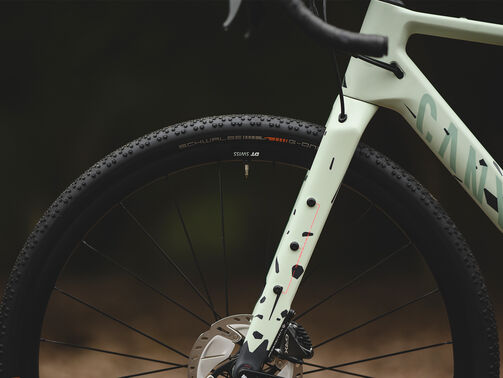Gravel bikes and suspension: Do you really need it?
Gravel bikes with suspension are redefining what’s possible on mixed terrain. Explore the benefits–from enhanced comfort to superior control–and why this setup is becoming popular amongst adventurous riders.


Gravel biking is all about versatility, but do you really need suspension? While some swear by the simplicity of rigid setups, others find that a gravel bike front suspension transforms their ride.
Could switching to a suspension fork give your gravel bike a whole new gear on rough trails? Let’s take a look at what suspension could do for your gravel adventures.
Contents
Why suspension on gravel bikes is a game-changer
Suspension is becoming a popular choice on gravel bikes, especially for cycling versatility on both smooth roads and rugged trails. Suspension is ideal for smoothing out medium gravel and diverging onto bigger dips, allowing for a more comfortable ride where a rigid fork might struggle.
For adventurous riders, suspension opens up new possibilities, allowing you to explore paths that would be too rough for a traditional gravel bike. It’s also a great way to ease into gravel biking, smoothing out the rough spots and making the ride more enjoyable when you’re just getting started.
Enhanced comfort on bumpy terrain
That 30mm of fork movement from the suspension system is great for eating up small trail chatter, such as small rocks, tight brake bumps and gravel sections. Where suspension really shines is being able to smooth out roots, drops and rocky gravel.
All this added comfort helps reduce fatigue on long-distance single-track rides while still providing a responsive feel on technical climbs.
Superior control and stability
Suspension on gravel bikes enhances traction and control. By absorbing shocks and vibrations, it keeps the wheels in better contact with the ground, providing stability on loose gravel and rocky sections.
This increased control is especially valuable on rough terrain and fast descents, where suspension ensures the front tyre stays in contact with the ground, improving both braking power and overall safety.
Faster and more confident riding
The added comfort from suspension reduces rider fatigue over long distances, allowing for sustained high performance. When you feel less beaten up by the terrain, you can focus more on maintaining a consistent pace and handling technical sections with precision.
All that extra comfort, control and reduced physical strain ultimately leads to a more confident riding experience, enabling you to push your limits on those challenging routes.

Comparing rigid vs. suspension gravel bikes
You can do a remarkable amount of riding on a rigid bike with good tyres and a carbon fork, especially when sticking to gravel roads that are mostly smooth dirt paths or gravel with occasional rough patches. (For a deeper dive into the benefits of carbon forks and frame materials, check out our detailed comparison between aluminium and carbon gravel bikes.)
A suspension fork becomes a significant advantage on very rough roads or single tracks where it can absorb bigger hits and make full use of its damper.
Suspension fork vs. rigid fork on gravel bikes
| Feature | Suspension Fork | Rigid Fork |
|---|---|---|
| Comfort | High comfort on rough terrain, absorbs shocks. | Moderate comfort relies on tyre volume for shock absorption. |
| Control and Stability | Enhanced control and better traction on rough trails. | Adequate control on smoother gravel, less effective on rougher terrain. |
| Speed on Rough Trails | Faster on rough, technical sections due to better traction. | Slower on very rough terrains but faster on smooth gravel due to less weight. |
| Weight | Heavier, which may affect climbing and acceleration | Lighter, improving overall speed and efficiency on climbs. |
| Price | More expensive due to complex components. | Generally cheaper, fewer components to maintain |
| Ideal Terrain | Rough, technical trails, single tracks. | Smooth to moderately rough gravel roads. |
If your priority is speed, ranking in group events and occasionally riding on asphalt, the suspension on a gravel bike might slow you down.
However, if you value adventures, exploring back roads at your own pace and tackling rough, fast descents, the suspension will keep you more comfortable and in better shape on challenging terrain.
Common misconceptions about suspension in gravel biking
The question of extra weight often comes up when discussing suspension on a gravel bike. The added weight might be a consideration for race-oriented riders focused on saving every gram. However, for most riders, it won’t be much of an issue.
Take the Canyon Grizl 7 Suspension, for instance, with the 30mm RockShox Rudy XPLR fork, which weighs in at 2.87 lbs or 1.3 kg. While this suspension system adds some weight compared to a rigid carbon fork, the trade-off is improved comfort and control on rough terrain.
If I want suspension, why not just get an XC mountain bike? While mountain bikes excel on extremely rough terrain, a gravel bike with suspension strikes a better balance for mixed surfaces, offering enough comfort on gravel while remaining faster and more efficient on smoother roads.

Alternatives to suspension: wider tyres and lower pressure
Changing your gravel bike’s tyre setup to wider tyres and lower presser enhances traction and reduces jolts from rough terrain, making it a good option for speed-focused riders.
While improving vibration dampening and cushioning, this setup can’t match the shock absorption of suspension, which is key for maintaining traction and stability over roots, rocks, and tougher obstacles.
Consider whether the terrain you’re riding on requires the added support and control that only suspension systems can provide.
Canyon gravel bikes with front suspension: leading the way
Canyon bikes, such as the Grizl range, incorporate advanced front suspension. This allows for a smooth, controlled ride across varying terrains without sacrificing speed on smoother paths.
By offering wide tyre clearance, Canyon bikes ensure riders can pair their suspension with broader tyres, optimising comfort and performance. This combination makes Canyon gravel bikes a strong option for those who want to conquer both road and rugged terrain with confidence.

Why get a gravel bike with suspension?
Three words: Terrain. Terrain. Terrain. Suspension makes a huge difference with the chunkier stuff like roots and drops. Today’s innovative suspension designs mean that extra weight is negligible for most riders.
Thinking about a gravel bike with suspension? Compare Canyon’s gravel bikes lineup and pick the right one for your travels and adventures.
Discover our Gravel Bikes
Did this article help?
Thank you for your feedback
-
 About the author
About the authorKimberly Hobson
Get to know Kim Hobson, a digital marketer and copywriter with a passion for the outdoors and all things on wheels.








